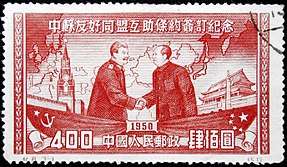Sino-Soviet Treaty of Friendship, Alliance and Mutual Assistance
The Sino-Soviet Treaty of Friendship, Alliance and Mutual Assistance (simplified Chinese: 中苏友好同盟互助条约; traditional Chinese: 中蘇友好同盟互助條約; pinyin: Zhōng-Sū Yǒuhǎo Tóngméng Hùzhù Tiáoyuè), or Sino-Soviet Treaty of Friendship and Alliance for short, is the treaty of alliance concluded between the People's Republic of China (PRC) and the Union of Soviet Socialist Republics (USSR) on February 14, 1950. It was based to a considerable extent on the 1945 prior Treaty of the same name that had been arranged between the Soviet Union and the Nationalist Government of China and it was the product of extended negotiations between Liu Shaoqi and Joseph Stalin. By its terms the USSR recognized the People's Republic of China and recalled recognition of the Republic of China.
 A Chinese postage stamp commemorating the treaty's signature | |
| Signed | 14 February 1950 |
|---|---|
| Expiry | 16 February 1979 |
| Signatories | Joseph Stalin; Mao Zedong |
Mao travelled to the USSR in order to sign the Treaty after its details had been concluded, one of only two times he travelled outside China in his life. The Treaty dealt with a range of issues such as Soviet privileges in Xinjiang and Manchuria. Specifically the Chinese Eastern Railway and the ports of Dalian and Lushun were to be returned to China.[1] One of its most important points was the provision of a $300 million loan from the USSR to the PRC, which had suffered economically and logistically from over a decade of intense warfare. The treaty did not prevent relations between Beijing and Moscow from drastic deterioration in the late 1950s – early 1960s, at the time of the Sino-Soviet split.
After expiration of the treaty in 1979 Deng Xiaoping wanted China not to negotiate with the Soviets unless they agreed to China's demands. Among them were demands that the Soviets withdraw from Afghanistan, remove their troops from Mongolia and the Sino-Soviet border, and cease support of the Vietnamese invasion of Cambodia.[2] Expiration of the treaty allowed China to attack Vietnam, a Soviet ally, in the Third Indochina War as a response to Vietnam's invasion of Cambodia, as the treaty had prevented China from attacking Soviet allies.
See also
External links
- An article which mentions the treaty.
- Yang Kuisong, "The Sino-Soviet Alliance and Nationalism: A Contradiction" (PDF). Archived from the original (PDF) on 2007-03-18. (103 KiB) (2005), Parallel History Project (PHP).
References
- Zhang Shengfa, "Return of the Chinese Changchun Railway to China by the USSR." In Manchurian Railways and the Opening of China, 171–94. 1st ed. Vol. 1. New York, NY: Taylor & Francis Group, 2010. Page 171.
- Joseph Y.S. Cheng "Challenges to China's Russian Policy in Early 21st Century." in: Journal of Contemporary Asia, Volume: 34 Issue: 4 (November 1, 2004), p 481
Further reading
- Peskov, Yuri. "Sixty Years of the Treaty of Friendship, Alliance and Mutual Assistance Between the U.S.S.R. and the PRC, February 14, 1950." Far Eastern Affairs (2010) 38#1 pp 100–115.